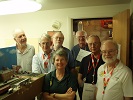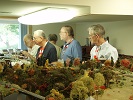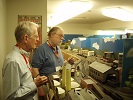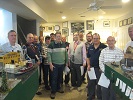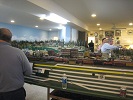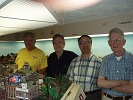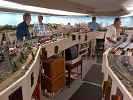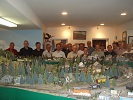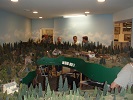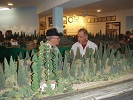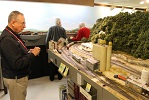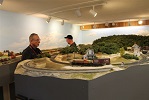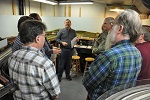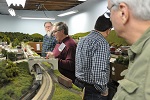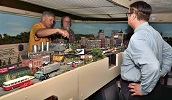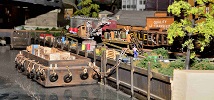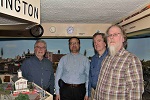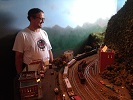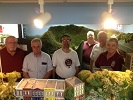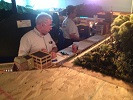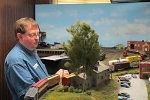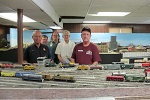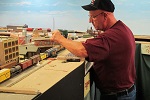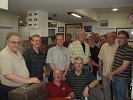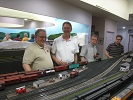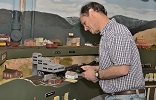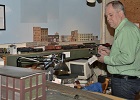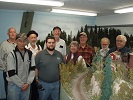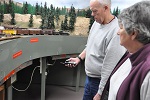

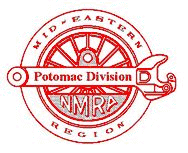
About the “Operations Initiative”
The “Operations Initiative” was a Potomac Division activity to provide
opportunities for members to participate in model railroad operating
sessions.
The intent of the Operations Initiative was several-fold.
 There are many
members in the Division that don’t have layouts, but enjoy operating
scale model trains. By having members with layouts open them up on a
weekend for an operating session that anyone in the Division can
sign up for can give folks without layouts an opportunity to operate
model trains.
There are many
members in the Division that don’t have layouts, but enjoy operating
scale model trains. By having members with layouts open them up on a
weekend for an operating session that anyone in the Division can
sign up for can give folks without layouts an opportunity to operate
model trains.
 While many of us
have model railroads in our homes, some just operate them by
themselves. Depending on your model railroading focus, you may
operate your layout often, or you may focus perhaps on scenery and
model building, and operate your layout infrequently.
While many of us
have model railroads in our homes, some just operate them by
themselves. Depending on your model railroading focus, you may
operate your layout often, or you may focus perhaps on scenery and
model building, and operate your layout infrequently.
 An interesting and fun facet of model railroading is operations.
Operating with others, and running trains in a more prototypical
manner, is both challenging and fun.Activities may include:
An interesting and fun facet of model railroading is operations.
Operating with others, and running trains in a more prototypical
manner, is both challenging and fun.Activities may include:
 Participating in an operating session can help you learn about
operations and how an operating session is put together. The
Initiative was intended to give folks that do not have layouts or do
not belong to an operating group, but are interested in the
Achievement Program, to log operations time towards their Dispatcher
Certificate. These were the sessions:
Participating in an operating session can help you learn about
operations and how an operating session is put together. The
Initiative was intended to give folks that do not have layouts or do
not belong to an operating group, but are interested in the
Achievement Program, to log operations time towards their Dispatcher
Certificate. These were the sessions:
The intent of the Operations Initiative was several-fold.
 There are many
members in the Division that don’t have layouts, but enjoy operating
scale model trains. By having members with layouts open them up on a
weekend for an operating session that anyone in the Division can
sign up for can give folks without layouts an opportunity to operate
model trains.
There are many
members in the Division that don’t have layouts, but enjoy operating
scale model trains. By having members with layouts open them up on a
weekend for an operating session that anyone in the Division can
sign up for can give folks without layouts an opportunity to operate
model trains.  While many of us
have model railroads in our homes, some just operate them by
themselves. Depending on your model railroading focus, you may
operate your layout often, or you may focus perhaps on scenery and
model building, and operate your layout infrequently.
While many of us
have model railroads in our homes, some just operate them by
themselves. Depending on your model railroading focus, you may
operate your layout often, or you may focus perhaps on scenery and
model building, and operate your layout infrequently.  An interesting and fun facet of model railroading is operations.
Operating with others, and running trains in a more prototypical
manner, is both challenging and fun.Activities may include:
An interesting and fun facet of model railroading is operations.
Operating with others, and running trains in a more prototypical
manner, is both challenging and fun.Activities may include:
- Delivering goods via a freight train from a yard to an industry (or industries),
- Picking up goods in loaded cars from an industry
- Delivering cars to a freight yard where they will be sorted and put on trains to their final destination.
- Running a passenger train and making stops at various stations around the layout.
- Figuring out how to switch cars in a minimum amount of moves can be fun and challenging.
 Participating in an operating session can help you learn about
operations and how an operating session is put together. The
Initiative was intended to give folks that do not have layouts or do
not belong to an operating group, but are interested in the
Achievement Program, to log operations time towards their Dispatcher
Certificate. These were the sessions:
Participating in an operating session can help you learn about
operations and how an operating session is put together. The
Initiative was intended to give folks that do not have layouts or do
not belong to an operating group, but are interested in the
Achievement Program, to log operations time towards their Dispatcher
Certificate. These were the sessions:| Pete and Jane Clark — East Broad Top Railroad | Mat Thompson — Oregon Coast Railroad [Session 1] [Session 2] |
| Bill Demas — The Westmoreland Railroad | Brian Sheron, MMR — Long Island Rail Road, Port Jefferson Branch [Session 1] [Session 2] [Session 3] |
| Andrew Dodge — Colorado Midland Railway | Dale Latham — Piedmont Southern |
| Richard Steinmann — Erie-Lackawanna | Marshall Abrams — Abrams Railroad Empire (ARE) |
| Bob Rodriguez' Nickel City Line | Roger Sekera — Clinch Valley Lines |
| Pete LaGuardia — The New York Central Western Illinois Division | Tom Brodrick — Providence and Worcester |
Click on picture for enlargement.
Pete and Jane Clark’s East Broad Top Railroad
Widening my Horizons
by Bill Mosteller
When I first started into model railroad operations, I imagined
several
requirements for a model railroad that was enjoyable to
operate.
No doubt, that list started with features of railroads I enjoyed
operating on. But as I see more railroads, I discover that
there's more variety in enjoyable operating experiences, often
omitting
some of my "requirements."
The Saturday of Memorial Day weekend, Herb Biegel, Arthur Boyd, Bob Harlow, Harvey Heyser, John Madden, Ron Polimeni, and I descended on Pete and Jane Clarke for an afternoon of Eastern narrow gauge railroading. Pete served as roving troubleshooter, Jane as dispatcher, and the rest of us happily ran trains.
While I've operated on the EBT before, I was reminded that I don't miss what's "missing." The East Broad Top has no hidden staging, and practically no hidden track. As a narrow gauge railroad that connects only with the Pennsy, in only one location, Mount Union, interchange traffic is modest. (The EBT did re-truck standard gauge cars for movement over the EBT, but that traffic was a small portion of what the railroad did.)
My job today was General Freight. Lest one might think that an important rank in the hierarchy, remember that the train is an extra (inferior to practically everything on the railroad) and that the EBT is really a coal hauling railroad. I started out at Orbisonia, went on to Robertsdale, switched cars there, then returned to Orbisonia, and went on to Mt. Union. In operating, one important skill is situational awareness. For example, on most model railroads, working a siding is likely to mean picking up freight cars on the siding that are going your way, and dropping off cars destined there. (Without such exchanges, the sidings would all fill up!) Another example has to do with where cars are going. At Mt. Union, I picked up a standard gauge car destined for someplace in Virginia, I forget where, and brought it with me back to Orbisonia. Only when I arrived did Pete question that inclusion in my train, and I realized that if that car is outbound from the EBT, with the only interchange is at Mt. Union, I should have ignored it. Oops. But that's how we learn. Thanks, Pete and Jane!
The Saturday of Memorial Day weekend, Herb Biegel, Arthur Boyd, Bob Harlow, Harvey Heyser, John Madden, Ron Polimeni, and I descended on Pete and Jane Clarke for an afternoon of Eastern narrow gauge railroading. Pete served as roving troubleshooter, Jane as dispatcher, and the rest of us happily ran trains.
While I've operated on the EBT before, I was reminded that I don't miss what's "missing." The East Broad Top has no hidden staging, and practically no hidden track. As a narrow gauge railroad that connects only with the Pennsy, in only one location, Mount Union, interchange traffic is modest. (The EBT did re-truck standard gauge cars for movement over the EBT, but that traffic was a small portion of what the railroad did.)
My job today was General Freight. Lest one might think that an important rank in the hierarchy, remember that the train is an extra (inferior to practically everything on the railroad) and that the EBT is really a coal hauling railroad. I started out at Orbisonia, went on to Robertsdale, switched cars there, then returned to Orbisonia, and went on to Mt. Union. In operating, one important skill is situational awareness. For example, on most model railroads, working a siding is likely to mean picking up freight cars on the siding that are going your way, and dropping off cars destined there. (Without such exchanges, the sidings would all fill up!) Another example has to do with where cars are going. At Mt. Union, I picked up a standard gauge car destined for someplace in Virginia, I forget where, and brought it with me back to Orbisonia. Only when I arrived did Pete question that inclusion in my train, and I realized that if that car is outbound from the EBT, with the only interchange is at Mt. Union, I should have ignored it. Oops. But that's how we learn. Thanks, Pete and Jane!
Mat Thompson’s Oregon Coast Railroad
by Bill Lyders (who also shot the photos above)
On Sunday, February 28th, 2016, Gil Fuchs and I worked well as
an Engineer-Conductor team and both got to
play each role – see the picture. We both expressed our
suggestions on
how to go about picking up and setting out cars along our
routes.
Usually it was either suggested sequence would work, so we just
did
one. But we did learn a couple of operations lessons. One is to
study
the whole route and realize that if you have an out and back
route, it
might make some of those later set outs easier if you don't do
an
earlier pickup. We had a challenging turnaround requiring an
engine/caboose turnaround in a tight industry location. It would
have
been a lot easier with fewer cars to do the runaround. A second
route
had us pulling a full 18 car train after picking up 11 cars in a
yard
on the way. We did take note to wait for another Extra that was
also
late getting started coming in the other direction but we
missed
that one car we took to the end should have been left at that
first
yard - we didn't read our way bill close enough.
So we both had a great Ops session and learned something as well.
So we both had a great Ops session and learned something as well.
Logging in the Pacific Northwest
by Bill Mosteller
Division members Gil Fuchs, Shawn Hogan, Robert Hogan, Bill
Lyders,
Doug Moore, and John Paganoni joined me at Mat Thompson’s
for an
operating session. I was partnered with Jerry Wolfson
and we were
assigned a pair of logging trains. As he brought his
throttle, we
decided he should drive and I should plan the moves.
Our first assignment was to move a 14 car log train from Astoria to Tilllamook. While I’ve run log trains before, this one was a lot longer than any previous assignment. The job included bringing the train in off a branch line, turning it (reversing engine and caboose), and proceeding to Tillamook. There, we offloaded the cargo of logs and turned the train. Finally, we returned to Astoria. This proved to be an excellent warm-up exercise for our next job.
We were then assigned a train from Hoyt Street to Tillamook (most logs go there). We started light (engine and caboose only) but didn’t stay that way. At our first stop, Willbridge and the Camp 18 Branch, we had to shift cars between three different sidings and finish up with a train of two log cars pointed the correct direction. I never worry about minimizing moves in these situations: too hard! I just try to get it done right. From there we moved to Clatskanie and the Victoria Branch. Three cars were waiting for us at Clatskanie, but hard experience has taught me not to drag things along if I’m coming back, so we left five log cars there and climbed the branch. Three more log cars awaited us, we ran around them and backed down the branch to the rest of our train. From there, after dodging scheduled trains (the log train was an extra) we finally reached Tillamook and the end of the session. We had a great time.
Our first assignment was to move a 14 car log train from Astoria to Tilllamook. While I’ve run log trains before, this one was a lot longer than any previous assignment. The job included bringing the train in off a branch line, turning it (reversing engine and caboose), and proceeding to Tillamook. There, we offloaded the cargo of logs and turned the train. Finally, we returned to Astoria. This proved to be an excellent warm-up exercise for our next job.
We were then assigned a train from Hoyt Street to Tillamook (most logs go there). We started light (engine and caboose only) but didn’t stay that way. At our first stop, Willbridge and the Camp 18 Branch, we had to shift cars between three different sidings and finish up with a train of two log cars pointed the correct direction. I never worry about minimizing moves in these situations: too hard! I just try to get it done right. From there we moved to Clatskanie and the Victoria Branch. Three cars were waiting for us at Clatskanie, but hard experience has taught me not to drag things along if I’m coming back, so we left five log cars there and climbed the branch. Three more log cars awaited us, we ran around them and backed down the branch to the rest of our train. From there, after dodging scheduled trains (the log train was an extra) we finally reached Tillamook and the end of the session. We had a great time.
Bill Demas' The Westmoreland Railroad
by Tom Gaffuri
Click
Here
for Slide Show
I attended an enjoyable operating session on Bill Demas’
Westmoreland Railroad. I have found that each
operating
session is a learning experience in addition to making
new friends and
getting reacquainted with old friends.
attending were Brian Sheron, Bill Mosteller, Gary Eames,
Herb Biegel,
Alban Thiery and myself, Tom Gaffuri.
The Westmoreland is a freelanced Class 1 railroad set in the transition era. For more information on The Westmoreland visit the Potomac Division website.
Bill has designed and built a point-to-point layout, with quite a bit of operation, in a compact space that kept the operators busy. Multiple industrial areas, two yards and a lot of switching. Typical consists are made up of a single loco, four 40 foot cars plus a caboose which allows a considerable amount of activity to take place. The aisles are wide and the operators have plenty of space to complete their work.
The Westmoreland is powered by a Digitrax DCC system using tethered throttles. Several of the locos are sound equipped and many of the locos have been repainted with The Westmoreland logo.
If you have not attended an operating session I encourage you to sign up for one. Even if you do not have your own layout or have not operated on someone else’s layout you will find that your host and other attendees are more than willing to help you to learn about operations.
The Westmoreland is a freelanced Class 1 railroad set in the transition era. For more information on The Westmoreland visit the Potomac Division website.
Bill has designed and built a point-to-point layout, with quite a bit of operation, in a compact space that kept the operators busy. Multiple industrial areas, two yards and a lot of switching. Typical consists are made up of a single loco, four 40 foot cars plus a caboose which allows a considerable amount of activity to take place. The aisles are wide and the operators have plenty of space to complete their work.
The Westmoreland is powered by a Digitrax DCC system using tethered throttles. Several of the locos are sound equipped and many of the locos have been repainted with The Westmoreland logo.
If you have not attended an operating session I encourage you to sign up for one. Even if you do not have your own layout or have not operated on someone else’s layout you will find that your host and other attendees are more than willing to help you to learn about operations.
On Sunday,
September 20th, 2015, Bob Harlow, Bill Demas, Bill
Mosteller, and Alban
Thiery operated on Brian Sheron's Long Island Rail Road.
"Sunday
afternoon was a great time for a drive in the country,
at least if it
was a drive to Brian Sheron’s Long Island RR layout in
Poolesville for
an introduction to operations. Three of us new to
operating
had a
fine low-pressure time learning some of the basics, and
the ICC
accident investigators did not need to be called in for
any
mistakes. Brian, assisted by Bill Demas, guided us
through
running way freights, and made sure LIRR passenger
service -- always a
real-world complication --did not get in our way.
We could
almost
hear the horns of frustrated motorists as we blocked
crossings trying
to figure out expeditious ways of delivering and picking
up cars at
various industries. In spare moments we marveled
at the
detailed
urban industrial scenes we were running through. A
very good
time
was had by all, and thanks are due to Brian and others
who make these
sessions possible. Why didn’t we get into this
sooner, and
what
are the rest of you waiting for?
"One of the things that I found most valuable was the way in which operations were simplified beyond what would happen in a normal session. As a beginner, it is hard to remember all the things to do, and it was helpful to start at a very basic level. For example, I tried to incorporate bell and horn use (which I know most of the rules for), but found it interfered with more basic things like deciding where to park and separate the train for efficient switching."
"One of the things that I found most valuable was the way in which operations were simplified beyond what would happen in a normal session. As a beginner, it is hard to remember all the things to do, and it was helpful to start at a very basic level. For example, I tried to incorporate bell and horn use (which I know most of the rules for), but found it interfered with more basic things like deciding where to park and separate the train for efficient switching."
Mat Thompson’s Oregon Coast Railroad
On
Saturday, June 6th, 2015, John Barry, David Correia,
Clarence Guenther,
Shawn Hogan, Robert Hogan, Jim Kinder, John King, Pete
LaGuardia, Bill
Lyders, Bill Mims, Chris Mitchell, Dave Mitchell,
George Meyrick, Bill
Mosteller, John Paganoni, Phil Raymond, and Alban
Thiery operated on
Mat Thompson’s Oregon Coast Railroad. A great
time was had by
all.
Mat’s railroad is masterfully done. Until recently, my girlfriend lived in the Pacific Northwest, and I can say with confidence that the scenery completely captures the look of that area: plenty of coniferous trees, hilly, and rugged. See the web site: http://ocrrnet.ipage.com/ The layout was featured in Great Model Railroads 2014.
My assignment at this session was the Hoyt Street Yard Hostler. Generally, a hostler will move trains from the roundhouse to the ready track for train crews. On Mat’s railroad, additional duties include moving freight traffic arriving at Hoyt Street Yard and destined for off-railroad locations to staging, and pulling freight traffic destined for the railroad from staging. Both of these tasks are important for keeping the railroad working -- Hoyt Street Yard mustn’t fill up with off-railroad cars or it will freeze, and jobs throughout the railroad depend on incoming traffic. I was particularly pleased because while I was aware of the hostler job from the Achievement Program paperwork, I’d never done it before.
Mat’s railroad is masterfully done. Until recently, my girlfriend lived in the Pacific Northwest, and I can say with confidence that the scenery completely captures the look of that area: plenty of coniferous trees, hilly, and rugged. See the web site: http://ocrrnet.ipage.com/ The layout was featured in Great Model Railroads 2014.
My assignment at this session was the Hoyt Street Yard Hostler. Generally, a hostler will move trains from the roundhouse to the ready track for train crews. On Mat’s railroad, additional duties include moving freight traffic arriving at Hoyt Street Yard and destined for off-railroad locations to staging, and pulling freight traffic destined for the railroad from staging. Both of these tasks are important for keeping the railroad working -- Hoyt Street Yard mustn’t fill up with off-railroad cars or it will freeze, and jobs throughout the railroad depend on incoming traffic. I was particularly pleased because while I was aware of the hostler job from the Achievement Program paperwork, I’d never done it before.
Dale Latham's Piedmont Southern
Saturday's
session went well with few to no electrical or
mechanical
failures. Everyone seemed to have enjoyed
themselves,
although at
times the task at hand seemed overwhelming. The three
guest operators
ran the various local turns (Herb Bigel on the Hanover
Turn,
Paul
Hutchins on the Shenandoah turn and Dave Beckstein on
the Piedmont
turn). The session ended as all three returned
their locals
to
the division point yard. Thanks to Bill Miller, Bill
Roman and Mike
White for their assistance during the session.
Dale
Latham
Richard Steinmann's Erie-Lackawanna
The Potomac Division of the NMRA MER region had the
good fortune to see and
operate on Rich Steinmann's Erie Lackawanna, Morris
and Essex Division,
layout 31 January, 2015. Rich models the
portion between
Chatham
and Port Morris Jct. and works to a schedule
Washington to
Hoboken.
The early beginnings of the layout go back 25 years and reflect the layout design of that time, one or a few operators standing in the middle with the tracks going around the room. In these early beginnings Rich made some beautiful scratch built buildings typical of the local, some being exact models of specific buildings with beautiful trackwork. He then discovered operation and with the kids moving out, he got more "acreage" in which to build and now has a great layout for operation with some great scenery.
His printed schedule was the basis for this operating session, "loosely enforced" so crews new to operation would not feel "under the gun" which made for a operating session enjoyed by all. There was a yardmaster at the main yard and other crews ran several freight, through passenger and commuter trains over the entire line fed by the double ended staging yard. Rich provided additional interest and variety with the Morristown and Eastern shortline connection being worked by a two man crew, another two man crew worked a local and the other shortline connection at Wharton. The shortline at Wharton is the Mount Hope Mineral RR which connects with the CNJ High Bridge Branch on the hill in Wharton.
Car cards and waybills provided the necessary information for the crews switching the freight cars. In key places were track diagrams and other information handy for the crews to better accomplish their tasks. With the use of "virtual" signals, a well thought out operating scheme and easy to read and follow "paperwork", the session made for "gentle" and rewarding challenges. Rich's easy going approach, realistic and prototype based layout made for a really great time for the visitors. One item that helped add to the pleasure was good tackwork and equipment with no significant electrical or mechanical issues. Unique to this session was a CSX engineer who could get the job done without the normal issues with management or union. Rich's unique methods to add track will be the subject of an upcoming article in the Layout Design Sig publication.
Another enjoyable Operating Session on Brian Sheron’s Long Island Railroad layout was attended by Martin Brechbiel, Alban Thiery, Bill Mosteller and Tom Gaffuri on Saturday, November 22nd, 2014. Brian’s layout is based on the LIRR’s Port Jefferson Branch circa 1964 and extends to the LIRR’s terminus at Pennsylvania Station in New York City. The layout scenery is quite detailed throughout and includes a model of the LIRR’s Jamaica Station.
The mainline is a double track folded dog bone which gives the appearance of a four track main. There are two busy yards and Sunnyside and Holban each worked by a yardmasters while the engineers move the trains and perform some challenging (for me anyway) switching at several sidings and industries. Each attendee had the opportunity to be both yardmaster and engineer. Thanks to Brian for hosting.
The early beginnings of the layout go back 25 years and reflect the layout design of that time, one or a few operators standing in the middle with the tracks going around the room. In these early beginnings Rich made some beautiful scratch built buildings typical of the local, some being exact models of specific buildings with beautiful trackwork. He then discovered operation and with the kids moving out, he got more "acreage" in which to build and now has a great layout for operation with some great scenery.
His printed schedule was the basis for this operating session, "loosely enforced" so crews new to operation would not feel "under the gun" which made for a operating session enjoyed by all. There was a yardmaster at the main yard and other crews ran several freight, through passenger and commuter trains over the entire line fed by the double ended staging yard. Rich provided additional interest and variety with the Morristown and Eastern shortline connection being worked by a two man crew, another two man crew worked a local and the other shortline connection at Wharton. The shortline at Wharton is the Mount Hope Mineral RR which connects with the CNJ High Bridge Branch on the hill in Wharton.
Car cards and waybills provided the necessary information for the crews switching the freight cars. In key places were track diagrams and other information handy for the crews to better accomplish their tasks. With the use of "virtual" signals, a well thought out operating scheme and easy to read and follow "paperwork", the session made for "gentle" and rewarding challenges. Rich's easy going approach, realistic and prototype based layout made for a really great time for the visitors. One item that helped add to the pleasure was good tackwork and equipment with no significant electrical or mechanical issues. Unique to this session was a CSX engineer who could get the job done without the normal issues with management or union. Rich's unique methods to add track will be the subject of an upcoming article in the Layout Design Sig publication.
Brian Sheron's Long Island Rail Road (LIRR)
Another enjoyable Operating Session on Brian Sheron’s Long Island Railroad layout was attended by Martin Brechbiel, Alban Thiery, Bill Mosteller and Tom Gaffuri on Saturday, November 22nd, 2014. Brian’s layout is based on the LIRR’s Port Jefferson Branch circa 1964 and extends to the LIRR’s terminus at Pennsylvania Station in New York City. The layout scenery is quite detailed throughout and includes a model of the LIRR’s Jamaica Station.
The mainline is a double track folded dog bone which gives the appearance of a four track main. There are two busy yards and Sunnyside and Holban each worked by a yardmasters while the engineers move the trains and perform some challenging (for me anyway) switching at several sidings and industries. Each attendee had the opportunity to be both yardmaster and engineer. Thanks to Brian for hosting.
Tom Gaffuri
I
had an excellent afternoon operating session
at Brian's on the 22nd and
I just want to thank our host for opening up
his home and letting us
have this opportunity.
Martin
Brechbiel
Bob Rodriguez' Nickel City Line
Bob Rodriguez was the host for the NMRA
Potomac Division Ops Initiative on Saturday,
September 20th, 2014.
Seven operators spent the afternoon moving a
variety of freight
and passengers. The session kicked off
with an inbound
freight to
Nickel City along with an outbound consist for
the industrial area and
the consist to be broken down from Train 504T
(arrival at the end of
the previous session). The yard crew
went right to work
sorting
and clearing the arrival / departure tracks an
planning moves for the
rest of the session. Their efficiency
was recognized during a
lull in the session which was a result of the
yard crew clearing out
all inbound traffic and having outbound
consists ready upon the arrival
of the next freight(s). Trains did not
stay in Nickel City
long
which cleared the mainline and gave the yard
crew a chance to set up
cars early for the next session.
Passenger trains wrapped up the day and everyone was done by 5pm. Congratulations go out to George Meyrick for earning his Yardmaster certification and to Ernie Little (who came and played trains on his birthday) who earned his Master Dispatcher certification. We also want to welcome Alban Thiery who joined the group this session and was quickly pressed into service at the start of the fastclock. Job well done by all crews.
Passenger trains wrapped up the day and everyone was done by 5pm. Congratulations go out to George Meyrick for earning his Yardmaster certification and to Ernie Little (who came and played trains on his birthday) who earned his Master Dispatcher certification. We also want to welcome Alban Thiery who joined the group this session and was quickly pressed into service at the start of the fastclock. Job well done by all crews.
Marshall Abrams' Abrams Railroad Empire
Greg
took his train from East Babel Yard to the
town of Marshal where he
moved cars from industries to the Marshal Yard
for future departure and
spotted cars at industries as specified in his
Instructions. He also
moved a few cars among industries.
Paul took his train from South Babel to Vienna, did the pick-ups and drop-offs as specified, and returned to Babel. Cars for Carnegie and Carol Gardens are left on an interchange track by a through freight. Dave performed some local moves among industries, moved cars from the interchange track to industries, and vice-versa. Herb [left-hand picture above] took his train out of North Babel to the town of New Rochelle and Bergen, switching industries in each town, before returning to Babel.
This session was Bob’s first experience with operations [right hand picture above]. He ran a through freight from Marshal to Babel, where he spotted the cars as specified in his instructions. He then ran an Amtrak, which helped familiarize him with the layout. Herb wrote: “I very much enjoyed operating on the ARE. The information provided in your introductory email was very valuable and gave me a good insight as to how your railroad would operate. The concept of using Employee Instructions for routing makes operating on an unfamiliar railroad much easier. The RailOP feature made finding and selecting cars to be picked up or set out straightforward and eliminated the confusion that can be experienced when interpreting the routing on car cards. I liked the way the turnouts were wired to stop a train if the turnout was thrown against it. The signaling was also a big help. “Above all, I appreciated your tolerance of my mistakes.”
Paul took his train from South Babel to Vienna, did the pick-ups and drop-offs as specified, and returned to Babel. Cars for Carnegie and Carol Gardens are left on an interchange track by a through freight. Dave performed some local moves among industries, moved cars from the interchange track to industries, and vice-versa. Herb [left-hand picture above] took his train out of North Babel to the town of New Rochelle and Bergen, switching industries in each town, before returning to Babel.
This session was Bob’s first experience with operations [right hand picture above]. He ran a through freight from Marshal to Babel, where he spotted the cars as specified in his instructions. He then ran an Amtrak, which helped familiarize him with the layout. Herb wrote: “I very much enjoyed operating on the ARE. The information provided in your introductory email was very valuable and gave me a good insight as to how your railroad would operate. The concept of using Employee Instructions for routing makes operating on an unfamiliar railroad much easier. The RailOP feature made finding and selecting cars to be picked up or set out straightforward and eliminated the confusion that can be experienced when interpreting the routing on car cards. I liked the way the turnouts were wired to stop a train if the turnout was thrown against it. The signaling was also a big help. “Above all, I appreciated your tolerance of my mistakes.”
A large contingent of enthusiastic model
railroaders (shown above, Shawn Hogan, Bill
Mosteller, Robert Prosser, Alban Thiery,
Bill Lyders, George Meyrick, John
Huntzinger,
and Roger Boyce) participated in a
well-organized and enjoyable operating
session on
the afternoon of April 12, 2014 at the home
of Pete LaGuardia on his New York Central
Western Illinois Division (WID). This
session, part of the Potomac Division
Operations
Initiative involved personnel from two MER
divisions, Potomac and James River. Pete’s
operations choreographed an 18 person crew
into the roles of Engineer (4) &
Brakeman
(4) and WID location staff (10),
Superintendent, Dispatcher,
Yardmasters/Assistants,
Hostler, and Operator.
Pete LaGuardia's New York Central’s Western Illinois Division (WID), in Haymarket, VA, is set in 1953, is HO scale, and operates from Kansas City, Omaha, and Des Moines on the west, through Moberly (MO) and Hannibal (MO), to Danville (IL) and Indianapolis (IN) on the east. Bench and track work are 99% complete and scenery was started in January 2013. The WID fills a 35’ x 32’ room. The DCC control system is radio NCE with 7 power districts. We operated the WID using Pete’s throttles under Timetable & Train Orders (TT&TO) with Car Cards and Waybill system available from Albion Software, Ship It Car Cards. Crew communications to the Dispatcher was done using a PBX phone system. We operated under a 3:1 fast clock for an 8 hour session that lasted around 3 hours completing 11 train schedules. Operational activities had each major yard (Crotona, Hannibal, and Beaumont) managed by a Yardmaster and an Assistant Yardmaster. Each train had an experienced Engineer and a less experienced Engineer (operating as a Brakeman).
Both my journeys as an Engineer with Brakeman Bob Harmon started in Kansas City (West End Yard) once with a freight train and next with a passenger train. For Bob, from James River Division, this was his first operations session. So I took the opportunity to mentor him on the TT/TO process and operating on the WID. Bob couldn’t believe my patience answering all his questions, but it was FUN for both of us. In our first stop, we dropped off 20 cars and picked up 22 in the Crotona Yard under the complete control of Yardmaster (YM)/Assistant Yardmaster (AYM) Bryan Kidd/Shawn Hogan, shown above, as they made up new trains advised by Superintendent Pete LaGuardia. Leaving that yard, we journeyed around the layout until Hannibal YM/AYM Roy Gurnham/Robert Prosser, coordinating with Operator Bill Mosteller, directed us to drop off/pick up cars in Hannibal Yard. We completed our journey to Danville leaving our train in East End Staging Yardmaster Phillip Raymond’s capable hands.
On our second train journey, we took our steam passenger train NYC 6001 around the WID roundhouse on the way to Crotona to drop off a coach and get an observation car. Later we passed a train coming from the other direction run by Engineer/Brakeman John Huntzinger/Marie Moyer and working the industries at Calamia. The largest collection of train cars and human participants was at Crotona Yard, as it quickly fills up with cars requiring yard switching operations. Overall management of the session was performed by the Dispatcher, Mat Thompson. He oversaw east bound trains and west bound trains to make sure train meets were not a problem.
After the operations session, the crews relaxed in the crew’s lounge with a cold drink and cookies and peppered Pete with questions for about 30 minutes on how he conducted operations and future WID plans. I have since talked to some of the less experienced participants and they all really enjoyed the operations experience and looked forward to doing it again. The mood was always relaxed and friendly and everyone worked together to get the “work” completed. In fact, due to Pete’s organization of the session, most trains arrived on-time.
I’m fresh from an operating session at Tom Brodrick’s Providence and Worchester (aided by Marshall Abrams) where Bill Ataras, Bob Muilenburg, Bob Rosenberg, and I spend the afternoon running the railroad. The crew was evenly divided, two novices and two more experienced operators. A good time was had by all. One of our number noted that switching an industrial area is an intellectually challenging task. I certainly find it so. I was thrilled with how I was handling another area on Tom’s layout when I realized that I was about to push three cars into an industry in exactly the opposite order of what was called for!
I also spent Sunday afternoon working on Tom Broadrick’s P&W. It was only my second experience in model railroad operation, and while there were some improvements over the first time there were a few things that, had I known them up front, would have made my life that day much easier: Locating all the cars that I had to switch, for example, (especially the one that was hidden in the building) before I actually started moving them around would have helped a lot. Taking 5 cars from the interchange track and spotting them at different industries while removing the existing 5 cars from those same industries and leaving them for pick up back on the interchange track may not seem like that big a deal, but you might be surprised if you’ve never done anything like that before; think of it as a puzzle with the trains as the pieces. But I did have a lot of fun doing it and I’m looking forward to the next time I get a chance.
Pete LaGuardia's New York Central’s Western Illinois Division (WID), in Haymarket, VA, is set in 1953, is HO scale, and operates from Kansas City, Omaha, and Des Moines on the west, through Moberly (MO) and Hannibal (MO), to Danville (IL) and Indianapolis (IN) on the east. Bench and track work are 99% complete and scenery was started in January 2013. The WID fills a 35’ x 32’ room. The DCC control system is radio NCE with 7 power districts. We operated the WID using Pete’s throttles under Timetable & Train Orders (TT&TO) with Car Cards and Waybill system available from Albion Software, Ship It Car Cards. Crew communications to the Dispatcher was done using a PBX phone system. We operated under a 3:1 fast clock for an 8 hour session that lasted around 3 hours completing 11 train schedules. Operational activities had each major yard (Crotona, Hannibal, and Beaumont) managed by a Yardmaster and an Assistant Yardmaster. Each train had an experienced Engineer and a less experienced Engineer (operating as a Brakeman).
Both my journeys as an Engineer with Brakeman Bob Harmon started in Kansas City (West End Yard) once with a freight train and next with a passenger train. For Bob, from James River Division, this was his first operations session. So I took the opportunity to mentor him on the TT/TO process and operating on the WID. Bob couldn’t believe my patience answering all his questions, but it was FUN for both of us. In our first stop, we dropped off 20 cars and picked up 22 in the Crotona Yard under the complete control of Yardmaster (YM)/Assistant Yardmaster (AYM) Bryan Kidd/Shawn Hogan, shown above, as they made up new trains advised by Superintendent Pete LaGuardia. Leaving that yard, we journeyed around the layout until Hannibal YM/AYM Roy Gurnham/Robert Prosser, coordinating with Operator Bill Mosteller, directed us to drop off/pick up cars in Hannibal Yard. We completed our journey to Danville leaving our train in East End Staging Yardmaster Phillip Raymond’s capable hands.
On our second train journey, we took our steam passenger train NYC 6001 around the WID roundhouse on the way to Crotona to drop off a coach and get an observation car. Later we passed a train coming from the other direction run by Engineer/Brakeman John Huntzinger/Marie Moyer and working the industries at Calamia. The largest collection of train cars and human participants was at Crotona Yard, as it quickly fills up with cars requiring yard switching operations. Overall management of the session was performed by the Dispatcher, Mat Thompson. He oversaw east bound trains and west bound trains to make sure train meets were not a problem.
After the operations session, the crews relaxed in the crew’s lounge with a cold drink and cookies and peppered Pete with questions for about 30 minutes on how he conducted operations and future WID plans. I have since talked to some of the less experienced participants and they all really enjoyed the operations experience and looked forward to doing it again. The mood was always relaxed and friendly and everyone worked together to get the “work” completed. In fact, due to Pete’s organization of the session, most trains arrived on-time.
This past
weekend I attended another enjoyable and
informative operating session and had
the pleasant opportunity to meet other
model railroaders. The attendees were
Bob Shepard, Bob Sprague, John King,
Herb Biegel and Jared Jacobs. Our host
was Roger Sekera and his Clinch Valley
Lines point-to-point layout is designed
for operations. Set in 1959, the Clinch
Valley Lines hauls coal and general
merchandise through Appalachia with
first generation diesels up front.
Operation is TT&TO which adds to the realism and kept John King at dispatch. The Clinch Valley Line is well marked with a separate dispatchers desk and lots of space for the five operators. Quite a bit of switching and one run I made lasted over an hour. As I design my layout attending operating sessions provides valuable information to incorporate into the design.
Operation is TT&TO which adds to the realism and kept John King at dispatch. The Clinch Valley Line is well marked with a separate dispatchers desk and lots of space for the five operators. Quite a bit of switching and one run I made lasted over an hour. As I design my layout attending operating sessions provides valuable information to incorporate into the design.
Tom
Gaffuri
Tom Broderick - Providence and Worcester
I’m fresh from an operating session at Tom Brodrick’s Providence and Worchester (aided by Marshall Abrams) where Bill Ataras, Bob Muilenburg, Bob Rosenberg, and I spend the afternoon running the railroad. The crew was evenly divided, two novices and two more experienced operators. A good time was had by all. One of our number noted that switching an industrial area is an intellectually challenging task. I certainly find it so. I was thrilled with how I was handling another area on Tom’s layout when I realized that I was about to push three cars into an industry in exactly the opposite order of what was called for!
Join in on the fun.
Bill Mosteller
I also spent Sunday afternoon working on Tom Broadrick’s P&W. It was only my second experience in model railroad operation, and while there were some improvements over the first time there were a few things that, had I known them up front, would have made my life that day much easier: Locating all the cars that I had to switch, for example, (especially the one that was hidden in the building) before I actually started moving them around would have helped a lot. Taking 5 cars from the interchange track and spotting them at different industries while removing the existing 5 cars from those same industries and leaving them for pick up back on the interchange track may not seem like that big a deal, but you might be surprised if you’ve never done anything like that before; think of it as a puzzle with the trains as the pieces. But I did have a lot of fun doing it and I’m looking forward to the next time I get a chance.
Bob Rosenberg
Brian Sheron - Long Island Rail Road (LIRR)
On March 9, 2014 I spent a fun and
informative afternoon at an
operating session hosted by Brian
Sheron on his Long Island RR Port
Jefferson Branch layout. Bill
Demas assisted Brian in working
the
operators - Herb Biegel, Glenn
Downing, Jared Jacobs, Alban
Thiery and me.
The layout is based on the Long Island Rail Road, Port Jefferson branch, circa 1964. It occupies two rooms in Brian's basement. The original layout and Long Island portion of it is in a 13' x 19' room. The newer part is in a 12' x 12' connected room, and in there Brian models the Long Island's Pennsylvania Station terminus in New York City. The mainline is a double track folded-dog bone, so on the straight stretches it appears to be a 4 track mainline. There are various industries located around the layout, and the layout has two major yards, Holban and Sunnyside.
The layout is quite impressive both in size and in the significant scene detail. The layout is well marked so that operators can readily navigate and find locations. For a novice like me this was essential. Although I must admit that I did make a couple of pilot errors (oops moments such as not verifying that I had the correct cars before leaving the yard and making switching moves more difficult than necessary).
This was a good learning experience for me since I am in the process of designing a layout for both operations and running. I would like to thank Brian for hosting this session.
I am looking forward to attending the upcoming operating sessions.
The layout is based on the Long Island Rail Road, Port Jefferson branch, circa 1964. It occupies two rooms in Brian's basement. The original layout and Long Island portion of it is in a 13' x 19' room. The newer part is in a 12' x 12' connected room, and in there Brian models the Long Island's Pennsylvania Station terminus in New York City. The mainline is a double track folded-dog bone, so on the straight stretches it appears to be a 4 track mainline. There are various industries located around the layout, and the layout has two major yards, Holban and Sunnyside.
The layout is quite impressive both in size and in the significant scene detail. The layout is well marked so that operators can readily navigate and find locations. For a novice like me this was essential. Although I must admit that I did make a couple of pilot errors (oops moments such as not verifying that I had the correct cars before leaving the yard and making switching moves more difficult than necessary).
This was a good learning experience for me since I am in the process of designing a layout for both operations and running. I would like to thank Brian for hosting this session.
I am looking forward to attending the upcoming operating sessions.
Tom Gaffuri
I keep discovering variations in
operating model railroad’s schemes
that surprise me. Andrew Dodge,
MRR, is an accomplished and
published (Model Stock Pens Along
a Fascia, Model Railroader, May
2017) modeler. A key to
understanding his Colorado Midland
Railway is that the locomotives
are the focus. This makes perfect
sense, as Andrew built all the
steam engines in his basement
shop. He’s a bit of a throwback to
days of yore in model railroading,
a real craftsman. He built the
railroad to Proto 48 standards,
and thus has proved you can run
trains to such standards. The
railroad scenery is beautifully.
(Use Natural Soil and Rocks in
Scenery, Model Railroader,
September 2017)
The operating instructions include
mandatory stops not merely for
water, but also for coal, sand,
and cool-down after a hard run. (I
only remember hearing about such
for New Haven EP-5 “Jet” electric
locomotives.) The couplers are
prototype scaled and operate with
realistic latch pins. So yes, you
must open both knuckles before
coupling. Trains are short (mine
topped out at four cars), so there
is switching, but the locomotives
are the focus.
